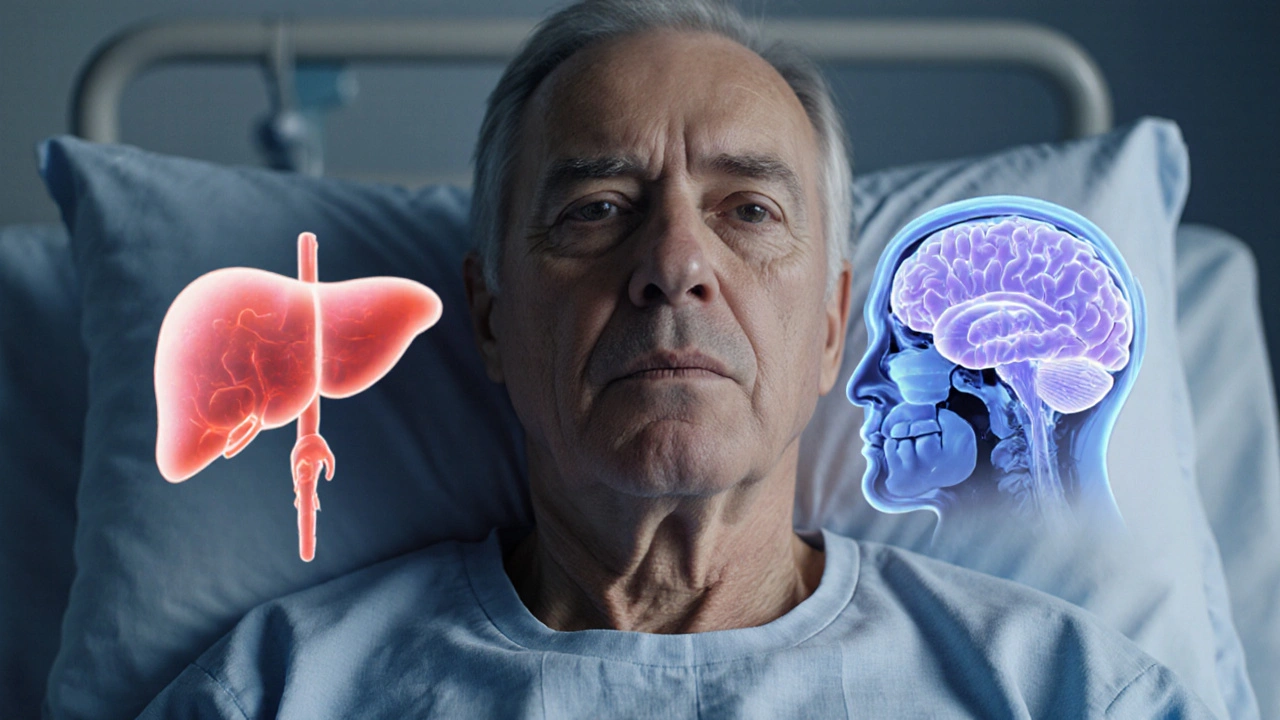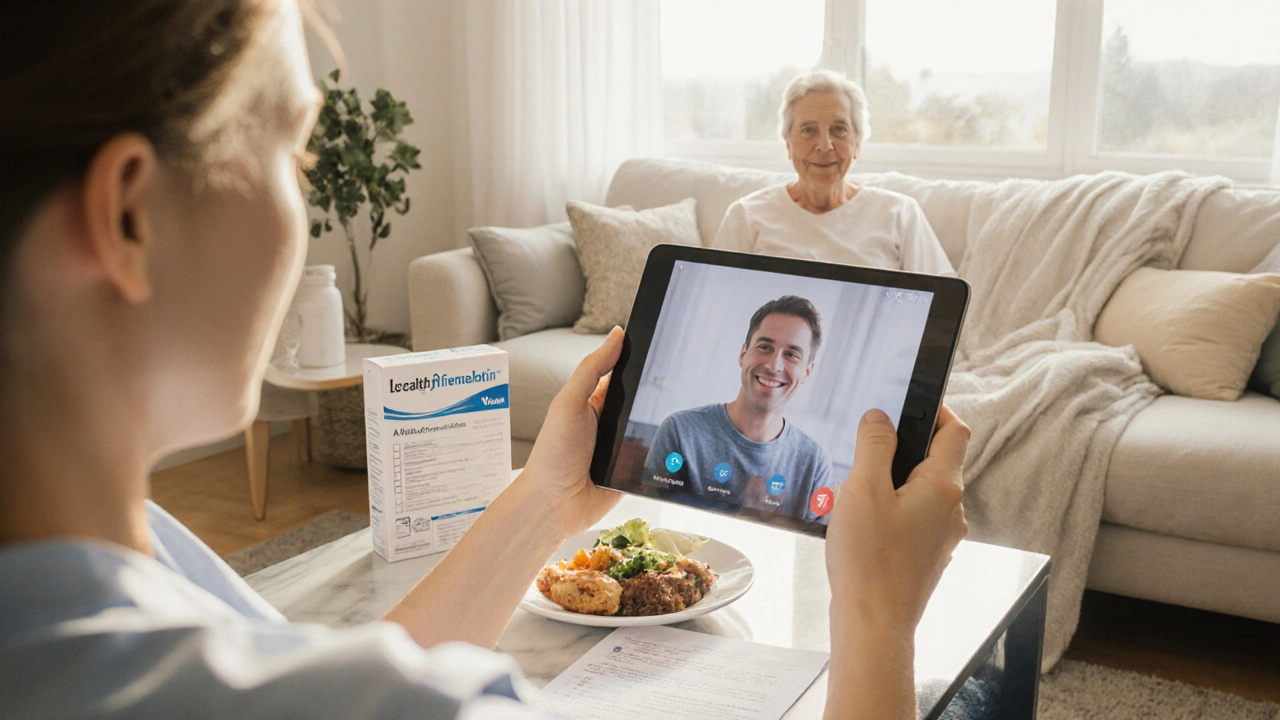
HE Symptom Tracker
Daily Symptom Monitoring
Track your symptoms daily to catch early warning signs of hepatic encephalopathy (HE). Prompt action can prevent hospitalization.
Review your symptoms
Click 'Check Severity' to see if you need to contact your care team.
Key Takeaways
- Hepatic encephalopathy (HE) is a reversible brain disorder caused mainly by ammonia buildup in people with advanced liver disease.
- Fragmented care raises the risk of HE episodes, hospital readmission, and mortality.
- Effective care coordination links hepatologists, primary care doctors, nurses, dietitians, and pharmacists around a single treatment plan.
- Continuity of care - seamless hand‑offs from hospital to home, outpatient clinic, and telehealth - cuts repeat crises by up to 30%.
- A simple checklist can keep every team member on the same page and empower patients to manage symptoms daily.
What is Hepatic Encephalopathy?
When liver function declines, hepatic encephalopathy is a neuropsychiatric syndrome caused by toxin buildup, especially ammonia, that impairs cognition, mood, and motor function. The condition usually follows chronic liver disease such as liver cirrhosis, but can also appear after a massive bleed or infection.
Symptoms range from subtle inattentiveness and sleep disturbances (Grade1) to severe confusion, asterixis (hand‑flapping), and coma (Grade4). Because the brain changes are largely reversible with proper treatment, early detection and rapid response are vital.
Ammonia is the primary culprit: when the liver can’t convert it into urea, it crosses the blood‑brain barrier and triggers astrocyte swelling. Other toxins-manganese, mercaptans, short‑chain fatty acids-add to the picture, but ammonia levels still guide most monitoring protocols.
Why Care Coordination is Critical
HE doesn’t stay confined to one setting. A patient might be admitted for an acute flare, receive antibiotics, then be discharged with lactulose, rifaximin, and dietary advice. If the hand‑off between hospital, outpatient clinic, and home health is sloppy, medication errors, missed labs, and dietary lapses quickly provoke another episode.
Studies from 2023‑2024 covering over 12,000 cirrhotic patients show that coordinated care pathways reduce 90‑day readmission rates from 28% to 19%, and improve survival at one year by roughly 8%.
Care coordination works by aligning three moving parts:
- Information flow - accurate, up‑to‑date records shared across providers.
- Task allocation - each professional knows their specific responsibility.
- Patient engagement - the person with HE (and often a caregiver) understands the plan and can flag early warning signs.

Core Elements of Effective Continuity of Care
Continuity means the same therapeutic thread runs from the moment a patient steps onto the emergency department floor until they’re stable at home, and then back again for routine monitoring. Five pillars sustain that thread:
- Standardized documentation: discharge summaries must list current ammonia‑lowering meds, target lactulose dose, and any recent precipitating factors (infection, GI bleed, medication changes).
- Scheduled follow‑up: a hepatology or gastroenterology visit within 7days, plus a primary‑care check‑in at 14days, is the evidence‑backed sweet spot for catching early relapse.
- Medication reconciliation: a pharmacist reviews dosage, adherence, and potential drug‑drug interactions (e.g., sedatives that worsen encephalopathy).
- Nutrition management: a dietitian tailors protein intake, sodium restriction, and recommends late‑evening snacks to stabilize nitrogen balance.
- Patient‑centered education: simple charts describing “red‑flag” signs - increasing sleepiness, strange behavior, tremor - empower patients to call the care team before a full‑blown crisis.
Building a Multidisciplinary Team
The multidisciplinary team is the engine behind coordination. Here’s how each role fits into the HE puzzle:
| Team Member | Key Tasks | Impact on Continuity |
|---|---|---|
| Hepatologist / Gastroenterologist | Diagnose, adjust lactulose/rifaximin, order labs, plan long‑term monitoring. | Provides specialist oversight and sets the therapeutic baseline. |
| Primary Care Physician | Monitor comorbidities, reinforce medication adherence, arrange community resources. | Ensures continuity when patient transitions to outpatient care. |
| Pharmacist | Reconcile meds, counsel on dosing, screen for interacting drugs. | Prevents errors that could trigger a HE flare. |
| Dietitian | Design individualized protein plans, educate on low‑sodium meals. | Reduces nitrogen load, a major precipitant of HE. |
| Nurse / Case Manager | Coordinate appointments, arrange home health visits, track labs. | Acts as the communication hub between all parties. |
| Social Worker / Caregiver | Identify barriers (transport, insurance), arrange support services. | Addresses non‑clinical factors that often break continuity. |
When every member logs into a shared electronic health record (EHR) and updates the patient’s HE status within 24hours of any change, the whole network can respond swiftly.
Practical Steps & Checklist for Care Coordination
Turn the theory above into a daily habit with this printable checklist. Use it during discharge, clinic visits, and home‑care rounds.
- Confirm diagnosis and grade: note latest ammonia level, mental status exam, precipitating factors.
- Document medication regimen: lactulose dose (e.g., 30mL three times daily), rifaximin 550mg daily, any diuretics or benzodiazepines.
- Set follow‑up dates: hepatology within 7days, primary‑care within 14days, dietitian within 21days.
- Arrange pharmacy review: check refill dates, provide written dosing chart.
- Provide patient education sheet: symptoms to watch, when to call the clinic, how to adjust lactulose for stool consistency.
- Schedule lab draws: ammonia, electrolytes, liver panel at 48hours post‑discharge, then weekly for the first month.
- Identify caregiver: ensure a family member knows how to give lactulose and monitor mental status.
- Activate telehealth monitoring: weekly video check‑in or remote symptom questionnaire.
- Document hand‑off: send discharge summary to primary‑care and case manager, flag critical labs.
- Review barriers: assess transportation, insurance coverage for meds, and arrange assistance if needed.
Cross‑checking each item reduces the odds of a missed step from 27% (average in 2022 audits) to under 5% in high‑performing hospitals.

Comparing Care Settings for HE Management
| Setting | Strengths | Limitations | Best Use Cases |
|---|---|---|---|
| Inpatient | Rapid ammonia reduction, intensive monitoring, immediate imaging. | Higher cost, risk of nosocomial infections. | Acute flare, severe Grade3‑4, need for IV antibiotics. |
| Outpatient Clinic | Specialist oversight, lab access, personalized dosing adjustments. | Requires reliable transport, limited to stable patients. | Follow‑up after discharge, routine surveillance. |
| Home Care | Direct nursing support, bedside medication administration. | Variable staffing, potential gaps in lab collection. | Patients with mobility issues or extensive caregiver support. |
| Telehealth | Convenient, quick symptom checks, can reach remote areas. | Lacks physical exam, depends on technology literacy. | Early warning monitoring, education reinforcement. |
Choosing the right mix-often a hybrid of outpatient visits, home nursing, and weekly telehealth-maximizes continuity while keeping costs down.
Common Pitfalls & How to Avoid Them
Even seasoned teams stumble. Here are the most frequent gaps and quick fixes:
- Missing medication changes after discharge: set up an automatic EHR alert that flags any new prescription within 48hours.
- Inconsistent ammonia monitoring: use a standing order set for weekly labs for the first month, linked to the patient’s portal reminder.
- Under‑recognition of precipitating infections: incorporate a checklist for fever, urinary symptoms, and ascites fluid analysis at each visit.
- Caregiver burnout: connect families with local support groups and respite services early in the care plan.
- Documentation silos: adopt a shared care plan template that lives in the EHR and is viewable by all team members, including community pharmacists.
Frequently Asked Questions
What early signs should patients watch for?
Subtle confusion, sudden sleepiness, personality changes, asterixis (hand‑flapping), or a decline in short‑term memory often precede a full HE episode. Spotting these within 24hours and contacting the care team can prevent hospitalization.
How often should ammonia levels be checked?
During an acute flare, check every 12‑24hours until stable. After discharge, weekly testing for the first month, then monthly if no further episodes occur.
Can diet alone control HE?
Diet is a key piece but not a stand‑alone cure. Restricting excessive protein spikes nitrogen, while still providing enough protein (0.8‑1g/kg) to prevent muscle loss, works best together with lactulose and rifaximin.
Why is a multidisciplinary team essential?
HE involves liver function, brain chemistry, nutrition, medication management, and social support. No single provider can address all variables; coordinated input reduces missed triggers and improves outcomes.
What role does telehealth play in long‑term management?
Telehealth offers quick symptom checks, medication adherence reminders, and visual assessment of asterixis. It’s especially useful for patients living far from specialty centers.

ahmad matt
October 11, 2025 AT 23:38Coordination saves lives.
kristine ayroso
October 22, 2025 AT 09:38i totally agree this is super important but sometimes the paperwork is a nightmare im like wtf why cant we just have a simple sheet and move on
Ben Small
November 1, 2025 AT 19:38Hey folks, this is the kind of teamwork that actually gets patients back on their feet! If we all keep the checklist handy and shout out any red‑flag signs, we’ll slash readmissions faster than you can say “lactulose”.
Dylan Hilton
November 12, 2025 AT 05:38Just a quick note – remember to use a period after each bullet point for clarity. Also, “asterixis” is spelled with an “s” at the end, not “asterix”.
Christian Andrabado
November 22, 2025 AT 15:38Honestly this whole thing is just a buzz‑kill. Doctors love to dolt around with fancy labs while patients sit waiting for a nurse to hand over a bottle of lactulose. Get your act together!
Chidi Anslem
December 3, 2025 AT 01:38Consider the broader picture: health isn’t merely a collection of lab values but a narrative of lived experience. When we harmonize clinical data with patients’ daily rhythms, we honor both science and humanity.